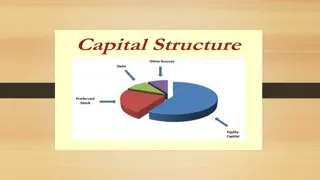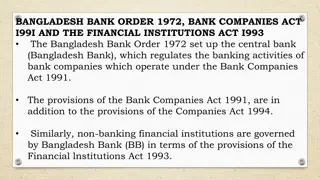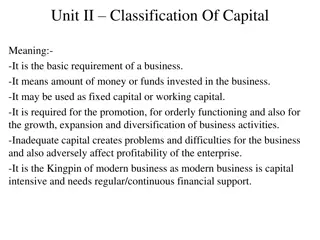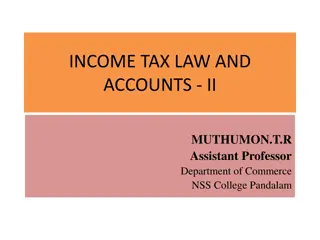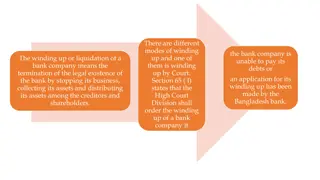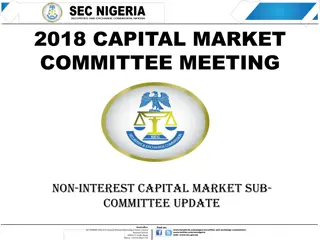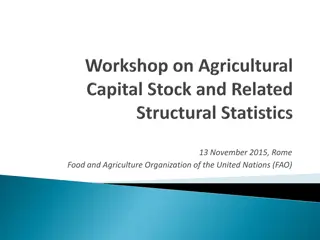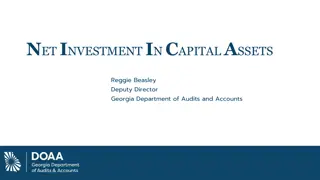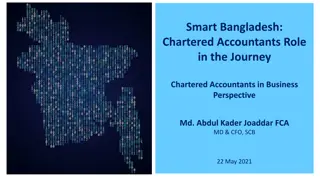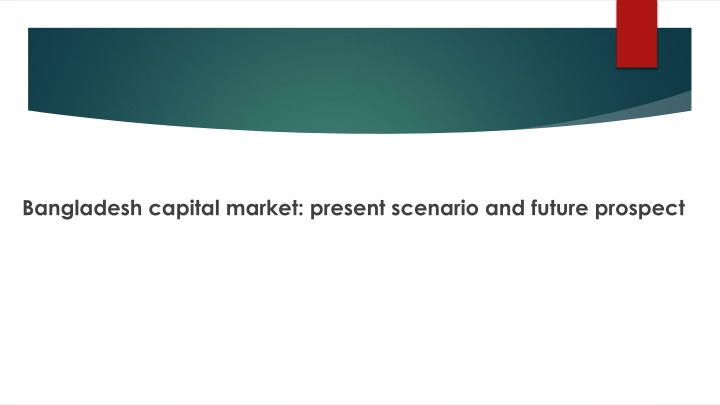
Ensuring Efficiency in Bangladesh Capital Market: Analysis & Future Prospects
Exploring the current scenario and future prospects of the Bangladesh capital market, this article delves into the features of a good capital market, the informational efficiency level, and the regulatory framework. It discusses aspects such as price discovery mechanism, transaction costs, insider trading regulations, and transaction costs, shedding light on key elements for a successful capital market.
Uploaded on | 2 Views
Download Presentation

Please find below an Image/Link to download the presentation.
The content on the website is provided AS IS for your information and personal use only. It may not be sold, licensed, or shared on other websites without obtaining consent from the author. If you encounter any issues during the download, it is possible that the publisher has removed the file from their server.
You are allowed to download the files provided on this website for personal or commercial use, subject to the condition that they are used lawfully. All files are the property of their respective owners.
The content on the website is provided AS IS for your information and personal use only. It may not be sold, licensed, or shared on other websites without obtaining consent from the author.
E N D
Presentation Transcript
Bangladesh capital market: present scenario and future prospect
Features of good capital market Market participant s financing, investment and risk management needs are often unique. In a good capital market, this demand and supply gap will eventually be narrowed down. Information symmetry is another key aspect. A good capital market should be efficient in weak-form, semi-strong and strong form. A good capital market ensures appropriate price discovery mechanism for the issued securities. Transaction costs both explicit and implicit costs should drop over time. A good capital market ensures price continuity for listed security.
Informational efficiency level of Bangladesh capital market Price of individual security and the index have autocorrelation components. Investors often fail to adjust past price and volume information promptly. On the brighter side, real-time market information can be accessed from anywhere across the globe. So, weak-form inefficiency is not due to any regulatory mismanagement, rather investors are bad-Bayesian.
Informational efficiency level of Bangladesh capital market - continued Dissemination of any price-sensitive information should be unbiased and simultaneous for all kind of market participants. In Bangladesh, price sensitive information has to be disseminated within 30 minutes to BSEC and stock exchanges. For communicating with the relevant stakeholders one Bengali newspaper, one English newspaper and one online newspaper and stock exchanges news monitor is used. So, our capital market should be able to react to any price-sensitive information on an unbiased and simultaneous basis.
Informational efficiency level of Bangladesh capital market - continued As per the existing regulation, company s director, major shareholder, managing agent, banker, auditor, advisor, employee all fits into the definition of an insider. Insiders are generally neither allowed to reveal price-sensitive information nor trade on the basis of these information (exceptions are allowed). Insider trading may result in suspension of license or even monetary penalty. So, there is a strong legal framework against insider trading.
Transaction cost The tick size is .10 taka. It is a very reasonable cost, even if we compare that with NYSE, where decimal pricing works. Official brokerage commission across the top brokerage houses is within .40 taka - .50 taka (out of 100 taka transaction) range over the years. On a real income basis, it is dripping over the years. Issue management fee (1% and 2% of the offer amount in case of fixed price method and book building method respectively) and underwriting fee (maximum 1% of the underwritten portion) are also reasonable under the international standards. The trade settlement process is brisk now and CDBL s performance has been very reliable. But transaction costs do entail implicit trading costs, delay cost, missed trade opportunity costs as well.
Price discovery Disclosure requirement under the prospectus/ red-herring prospectus/ information memorandum is detailed and very informative. Cut-off price determination process is flexible and integrated. 35% of the undersubscribed amount in an IPO will be underwritten by the investment banker through firm commitment. If under-subscription in any of categories is above 35%, the initial public offer shall be considered as cancelled. The legal framework allows ample opportunity for price discovery in an IPO.
Price discovery continued Financial statement disclosure frequency is of international standard four times (first quarter report, semi-annual report, third quarter report and audited annual report) a year. Financial statement disclosure quality has improved; for example the official definition of EPS diluted and sustainable earning. is Only an approved panel of auditors can perform auditing of listed firm s book of accounts. The legal framework allows ample opportunity for price discovery for the secondary market listed securities.
Price continuity There are standard upward and downward price change limits based on reference price/previous trading day s closing price. Circuit breaker will be applicable for IPOs from the 3rdtrading days. Market making is generally done at an informal level even though there is an official market maker rule since 2000. Since 2009, there are 456 instances broker/dealer, issue manager etc.) were penalized under different capacities and 462 instances whereby different market participants were warned. whereby different market participants (issuer, stock
Major challenges Bangladesh s corporate finance structure is not market driven rather it is dependent on bank-based solutions. Listed companies enjoy tax benefits in Bangladesh. Corporate tax rate for publicly listed companies is 25%, whereas 35% is the tax rate applicable for non-publicly traded firms. If any non-publicly traded company transfers minimum of 20% shares of its paid-up capital through IPO it would get 10% rebate on total tax in the year transfer. Still IPO is not the most popular financing mode to the entrepreneurs; entrepreneurs prefer the formal banking channel to finance their BMRE projects. Across time, IPO s contribution in the formal financing channel is less than 1%. Entrepreneur s lack of interest in the primary market driven financing can be attributed to the fear of equity dilution and adherence to excessive rules and regulation.
Major challenges continued Across the world, pension funds, hedge funds and insurance companies constitute the most vibrant group of institutional investors. In our country, we do not have any pension fund or hedge fund vesting in different asset classes. Bonds constitute 65%-70% of insurance companies investment portfolio. But in Bangladesh, we do not have an active bond market. There is no active secondary market for treasury securities; benchmark yield curve is non-existent in Bangladesh. Corporate bond market is of marginal size.
Major challenges continued Concurrent corporate governance regulations focus more on independent director inclusion and internal auditing process. But risk management, minority interest protection, compensation scheme of directors these issues should also be incorporated. So, the current practices do not correlate with Cadbury commission s (1992) guideline. Auditors are allowed to offer other revenue-generating services (like tax consultancy) to the firm it has audited. So, it does not correlate with Sarbanes-Oxley act s (2002) premise.
Future prospects Derivative market Should be focusing on the risk management strategies; futures for agricultural commodities, swaps for cash flow hedging, protective puts for equity investors. ABS market provides liquidity to financial institutions on long-term assets. EFT and index fund Suitable to passive portfolio managers. Venture capital and private equity injects business model of firms with weak asset base. necessary equity in the relatively new REIT provides investors with extreme liquid stake in real estate







